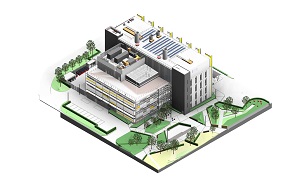New Health & Life Sciences Building plans published
Release Date 10 January 2017

Plans have been published for a new Health & Life Sciences Building at the University of Reading, which will cost more than £50m and provide 7,557m2 of lab and teaching space.
The project will see the consolidation of Reading’s Health and Life Sciences teaching, bringing together the School of Biological Sciences – currently hosted in six buildings across the Whiteknights campus - into a brand new facility.
The new building will include wet and dry research laboratories, teaching facilities and office space for academics, postgraduate researchers and administrative staff. It will also become the new site of the Cole Museum of Zoology.
Professor Steve Mithen, Deputy Vice-Chancellor, said:
“The Health & Life Sciences building will provide a world-class suite of teaching and research facilities, enabling us to continue our tradition of outstanding teaching in biological sciences and pioneering research that addresses the global challenges in biomedical science.
“It is just one of several multi-million pound investments within our current building programme designed to sustain, and further enhance, Reading’s status as a world leading teaching and research intensive university".
One of the largest teaching labs in the UK
Subject to planning permission, the new building will offer 7,557m2 of floor space over four floors and is expected to be complete by summer 2019. The site of the building will be in place of the current Engineering Building, which will be demolished in early 2017, and as it is situated between Wokingham and Reading Borough Council, Wokingham acting as the lead council for the application.
Teaching labs can be configured to teach groups of up to 280 – making it one of the largest teaching labs in the UK. In addition, two floors of research laboratory space will serve the needs of 95 academic researchers and 145 doctoral students.
The project forms part of the University’s £200 million capital investment programme 2026: TRANSFORM, and once the new building is completed, the University’s older AMS Tower, Knight and Harborne Buildings will be demolished.
Key features of the building include:
- A range of teaching laboratories and seminar rooms
- A bioresource unit (BRU)
- Research laboratories and write-up areas
- Offices and open plan areas for academic and support staff
- New location for the Cole Museum of Zoology
- New café
- Uniting the School - currently hosted in six buildings across the Whiteknights campus – to enable more efficient use of space and resources, allowing greater collaboration in research
The new facility will house a state of the art bioresource facility, where biomedical research which requires the regulated use of animals can take place under the highest standards. The facility is a critical part of the University’s current research to find new treatments for conditions such as epilepsy, heart disease and obesity.
The University of Reading is a signatory to the Concordat on Openness on Animal Research, along with 100 other UK universities, charities, and other groups, in a commitment to help the public understand more about animal research.
All of Reading's animal research is closely monitored, regulated and carried out according to the highest standards as set down by the Home Office, which licences animal research in the UK.